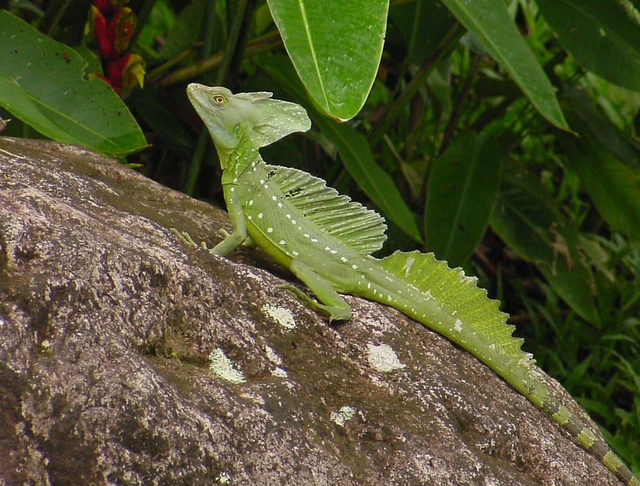
More about Basilisk
Habitat
The Common Basilisk lives along bodies of water in a variety of forests, including lowland dry, moist, and wet forests, and premontane moist and wet forests. Even in highly disturbed agricultural areas, they can survive in gallery forests or secondary growth near streams.
Range
Basilisk species usually live in low elevations, from sea level to 600 m. The species ranges from southwestern Nicaragua to northwestern Colombia on the Pacific side, and from central Panama to northwestern Venezuela on the Atlantic side.
Physical Description
This lizard can be distinguished from similar species within its range by its large size and the high finlike crests down its back. Males also have high crests on the head and tail. Both sexes are brown to olive, and have a white, cream or yellow stripe on the upper lip and a second stripe along either side of its body; these stripes have higher contrast in juveniles and fade as the lizards age.
Biology and Natural History
Nicknamed the “Jesus Christ Lizard,” this extraordinary reptile may run on water when threatened. This spectacle can be readily witnessed; adults often bask in daylight near water when they are not foraging or resting. At night they sleep on perches close to the ground or as high as 20 m.
When startled, the Common Basilisk escapes by speeding to the nearest edge of water—and continues sprinting. The lizard runs on only its hind legs in an erect position, holding its arms to its sides. This basilisk is so adroit on water because its feet are large and equipped with flaps of skin along the toes; when moving quickly, the lizard can cross a surface of water before sinking. On water it runs an average speed of 8.4 kph (or 5.2 mph), which is just a little slower than its speed on land. Younger basilisks can run 10 to 20 meters on water, while adults cross only a few meters before sinking. Adults do not move slowly, but they weigh more and cannot sprint for as long a time. Once a basilisk submerges, it continues swimming until it is sufficiently far from its pursuer—if the predator has followed past the bank! Although this lizard stays close to water to escape terrestrial predators, it swims only when necessary because there are aquatic animals that would be just as happy to eat the basilisk given the chance.
Females lay multiple clutches of 2 to 18 eggs. Larger females lay more eggs in each clutch. The young are left and hatch after 3 months. Only about 60% of hatchlings survive, as they have many predators. Raptors are the main pursuer, and opossums and snakes also prey on sleeping lizards. If it reaches adulthood, a male will live 4 to 6 years, slightly longer than females. An older dominant male will defend females that live within his territory from young competitors.
Diet
This lizard hunts a wide variety of active prey, including insects, scorpions, freshwater shrimp and fish, as well as small individuals of lizards, snakes, mammals and birds. They also forage on flowers, fruits and buds of plants that grow near water. Juveniles mostly eat insects but may also eat fish.
Height/Weight
Hatchlings weigh a mere 2 g and are 37 to 43 mm long. Adult males are generally 130 to 250 mm and weigh 600 g. Females are generally 135 to 194 and weigh half as much as males. The tails of these lizards comprise 70 to 75% of their total length: for example, on an 800 mm (or 31.5 in) long lizard, 600 mm of its length is tail.
Taxonomy
Order: Squamata
Family: Iguanidae
Sources
Leenders, Twan. A Guide to Amphibians and Reptiles of Costa Rica. Zona Tropical, S.A, Miami, FL, 2001.
Savage, Jay M. The Amphibians and Reptiles of Costa Rica: A Herpetofauna between two Continents, between Two Seas. The University of Chicago Press, Chicago, 2002.
Scott, N. J., J. M. Savage, and D. C. Robinson in Janzen, Daniel H. Costa Rican Natural History. Chicago: University of Chicago Press, 1983.
-Amy Strieter, Wildlife Writer
Basilisk Sightings
Similar Profiles
It's more than just having a good time or visiting beautiful places (although that's absolutely a part of it!), it's about being part of a unique experience that stays with you.



